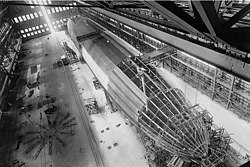1920s
1921
The first large US airship hangar is built at Lakehurst, New Jersey
On the fourth test flight of R-38 severe control inputs at low altitude and high speed cause the structural failure of the airship with the loss of the majority of the crew. [1] Sixteen of the men killed were USN training to fly the ship back to Cape May, NJ. [2] The ZR-2 (R38) crashed before the US Navy could take delivery of the airship; therefore ZR-2 did not officially receive its US designation, though it was painted with its planned Navy designation.
1922

The first American-built rigid airship, the USS Shenandoah, is built in Hangar No. 1 [3] at Lakehurst, New Jersey.
1923
August 20, The USS Shenandoah, is christened.
September, USS Shenandoah is launched and flown from Lakehurst, New Jersey. It was the first ship to be inflated with the noble gas helium, which was so rare that the Shenandoah contained most of the world's reserves. [3]
1924
The United States Navy purchases and takes delivery from Germany of the USS Los Angeles (ZR-3); the only German-built (as LZ 126) US Navy airship. The Los Angeles was paid for with "war reparations" money, owed according to the terms of the Treaty of Versailles, thus saving The Zeppelin Works. The success of the Los Angeles encouraged the US Navy to invest in its own, larger, airships. The Los Angeles flew successfully for 8 years.

November 25, USS Los Angeles is commissioned in Lakehurst, NJ. The two airships USS Shenandoah and USS Los Angeles had to share the limited supply of helium, and thus alternated operating and overhauls. [4]
The Los Angeles flew successfully for 8 years.
1925
September 3, USS Shenandoah was lost on a poorly planned publicity flight when it flew into a severe thunderstorm over Noble County, Ohio. It broke into pieces, killing 14 of its crew.
1926
June 24 (Washington, DC), The Navy department authorizes construction of two large dirigibles, named USS Akron (ZRS-4) and USS Macon (ZRS-5), to be the nucleus of the modern Air Force.
The US Navy developed the idea of using airships as airborne aircraft carriers, although the British had experimented with an airplane "trapeze" on their R33 . [ clarification needed ] The USS Los Angeles was used to experiment with the project, followed by two other airships, the world's largest at the time, to test the principle—the USS Akron and Macon. Each carried four F9C Sparrowhawk fighters in its hangar, and could carry a fifth on the trapeze. The idea had mixed results. By the time the Navy started to develop a sound doctrine for using the ZRS-type airships, the last of the two built, USS Macon, was lost. The seaplane had become more mature, and was considered a better investment. [5]
1929
A metalclad-airship, ZMC-2, is built by the Aircraft Development Corp (scrapped in 1941)

